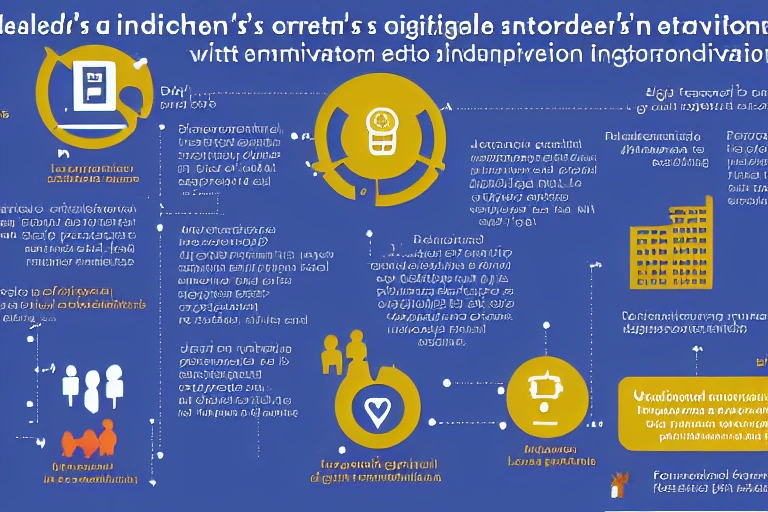Are you looking for a way to make your digital transformation journey more efficient and effective? Gartner has identified some key strategies that can help you reach your goals quickly and efficiently. In this blog post, we will discuss what Gartner suggests and how it can help you achieve success in your digital transformation. Read on to find out more!
Defining Digital Transformation with Gartner
Digital transformation is a process that organizations use to create a more agile, responsive, and innovative business. Gartner defines digital transformation as “a holistic process that enables an organization to create a customer-centric digital experience and deliver value to its customers through the application of technology.”
There are many benefits to using digital transformation strategies, including:
Reduced costs: By digitizing processes and automating workflows, organizations can reduce the costs of operations.
Improved customer experience: By building a more customer-centric digital experience, organizations can improve the customer experience and drive higher loyalty rates.
Increased agility: By adopting agile methodologies and technologies, organizations can increase their flexibility and responsiveness to changes in the marketplace.
In order to achieve these benefits, organizations must first understand the challenges of digital transformation. These challenges include:
Lack of clarity about what needs to be transformed: Many organizations are unsure about which aspects of their business need to be updated in order to meet the demands of the digital age.
Lack of leadership commitment: Leaders must be committed to digital transformation if it is going to be successful. Without leadership commitment, organizations may not be able to overcome resistance from within their organization or from external stakeholders.
Difficulty achieving consensus: As with any large-scale change initiative, achieving consensus among all stakeholders is often difficult. This can lead to delays in implementing digital transformation strategies.
Benefits of Gartner’s Digital Transformation Strategies
Gartner’s digital transformation strategies provide organizations with a blueprint for optimizing their digital capabilities and driving business value. By understanding the challenges and opportunities of digital transformation, leaders can create an environment that supports innovation and growth.
Digital transformation is a complex process that requires a coordinated effort from all parts of an organization. To achieve success, organizations must align business and IT goals, identify and assess risks, and implement a plan that leverages technology and human resources.
Gartner’s approach to change management is critical for any digital transformation project. Change management tools help organizations track progress, identify risks, and manage expectations. Gartner also offers guidance on how to measure the success of digital transformation projects.
Looking ahead, Gartner expects the most significant trends in digital transformation to include:
- Emerging technologies that will drive increased agility and disruption in the marketplace
- The continued adoption of cloud-based solutions by enterprises
- The growth of artificial intelligence (AI) and machine learning (ML)
Understanding the Challenges of Digital Transformation
In order to successfully implement digital transformation, organizations must first understand the challenges and opportunities that come with it. There are many different aspects to digital transformation, and each one presents its own set of challenges. In this section, we’ll look at some of the most common challenges and how to overcome them.
One of the biggest challenges in digital transformation is understanding how technology can help or hinder business goals. For example, if an organization wants to reduce costs, it may be necessary to change how it processes data. However, if the organization relies on a legacy system that requires a lot of data processing in order to function, then it may be difficult to make that change.
Another challenge is aligning business and IT goals. Often times, different parts of an organization have different goals for digital transformation. For example, marketing may want to increase online traffic and conversions, while IT may want to improve security measures. It can be difficult to find a single goal that everyone can agree on.
In order to overcome these challenges, organizations need a well-planned approach. They should also have a clear understanding of their current state and what needs to be changed in order for digital transformation to be successful. Finally, they need the resources necessary to make the transition happen.

The Role of Leadership in Digital Transformation
Leadership is essential for successful digital transformation. Leaders need to understand the importance of digital transformation and be willing to invest in it. They also need to be able to articulate the business case for digital transformation and ensure that everyone on the team is on the same page. Leaders also need to be able to provide clear direction and create an environment where everyone can work together to achieve success.

Leveraging Technology for Digital Transformation
Identifying Appropriate Technologies
Digital transformation is an effort to change the way an organization operates in order to improve its performance. The goal is to make the business more agile and responsive to changes in the marketplace, while reducing costs and increasing productivity. There are a number of ways to achieve digital transformation, but some key elements include effective communication and collaboration; developing new processes and capabilities; leveraging technology assets; and embedding digital technologies into organizational cultures.
Technology can play a critical role in achieving digital transformation goals. For example, it can enable organizations to quickly analyze data and make better decisions, increase customer engagement through interactivity, enable faster delivery of products or services, or help employees work from anywhere in the world. In order for technology to be most effective in support of digital transformation, it must be selected and applied intelligently.
To identify appropriate technologies for digital transformation, organizations first need to assess their current capabilities and needs. They should then consider the stage of the digital transformation process they are in (initial planning, developing plans, executing, or managing) and the types of technology that will be most effective in supporting that phase. Organizations should also keep in mind the long-term implications of technology choices as they move through different stages of the digital transformation process.
Technology can play a key role in helping to achieve many of the goals of digital transformation. However, it is important to select appropriately for each stage of the process and to understand both short-term and long-term implications.
Developing a Roadmap for Digital Transformation
The key to successful digital transformation is the utilization of technology in conjunction with an effective roadmap. A well-developed plan will help move organizations from one state of readiness for digital transformation to a fully realized and transformative organization. To achieve success, enterprises must first identify their needs and desired outcomes. This can be done through various methods such as user surveys, focus groups, interviews and analysis of organizational performance data (OPD). Once needs are identified, technology can then be integrated into the overall strategy to support business goals.
In order to transform successfully, it is important to have a clear understanding of what technology capabilities are needed in order to support agendas like customer experience mastery or advanced analytics initiatives. Planning for required technologies should take into account not only what is currently available, but also what is likely to be needed in the future. In order to ensure that technology investments are effective, it is important to have a roadmap in place that defines the specific steps and milestones that need to be achieved in order to realize desired outcomes.
Technology should not be viewed as a one-time expense; it should be an integral part of an overall strategy for digital transformation. By taking the time to plan and implement the right technologies, enterprises can create a foundation for future growth and success.
Implementing and Monitoring Technology Solutions
The implementation of technology solutions for digital transformation can be a time-consuming and complex process. To successfully achieve an efficacious and impactful transformation, organizations must first develops a roadmap that outlines the specific actions they will take to achieve their desired outcome. Once this roadmap is in place, implementing the required technology solutions can proceed at a more expedited pace. Likewise, effective digital transformation monitoring and management requires continual coordination among all involved parties, as well as regular reporting to stay on top of progress.
Maximizing Return on Investment
Digital transformation can be a costly endeavor, but it is important to ensure that the return on investment (ROI) is maximized. There are a number of ways to achieve this, including optimizing the use of technology, automating processes, and improving communication and collaboration.
Optimizing Technology Solutions
One of the most important ways to maximize ROI is to optimize the use of technology solutions. When implementing digital transformation, it is important to choose the right technologies and platforms for the task at hand. Technologies such as cloud computing, big data, and analytics can help organizations scale their efforts while reducing costs. Additionally, effective use of mobile devices and social media can help employees work from anywhere in the world.
Automating Processes
Another way to optimize ROI is to automate processes. By automating many of the functions that are currently performed manually, organizations can save time and money. Automation can also help ensure consistency and accuracy across various parts of an organization. Additionally, it can improve communication and collaboration by making tasks such as meeting scheduling easier.
Improving Communication and Collaboration
Effective communication and collaboration are key aspects of digital transformation. When implementing new technology solutions or automating processes, it is important to ensure that everyone in the organization understands what is happening. Communicating using effective technologies, such as video conferencing software or chatbots, can help achieve this goal. Additionally, effective use of social media can help employees stay up-to-date on changes and developments.

Gartner’s Approach to Change Management
Gartner’s Approach to Change Management
Change management is a critical part of any digital transformation project. Successful projects require clear objectives and milestones, well-defined roles and responsibilities, effective communication, and manageable expectations. Gartner’s approach to change management helps organizations identify gaps in their current change process, develop an action plan to address those gaps, and track progress throughout the project.
Aligning Business and IT Goals for Digital Transformation
Gartner’s Approach to Change Management
When it comes to change management, Gartner has a well-defined process that helps organizations successfully implement digital transformations. The key elements of this process include creating a change management plan, setting up communication channels, and ensuring that all stakeholders are aligned with the transformation.
Gartner also emphasizes the importance of continuously monitoring and measuring the progress of digital transformations. This allows organizations to make adjustments as needed and ensure that the end goal of the transformation is met.

Measuring the Success of Digital Transformation Projects
Establishing Quantifiable Metrics
When embarking on a digital transformation project, it is essential to have a clear understanding of the goals of both business and IT. By aligning these goals, an organization can develop a more efficient process while maximizing ROI. Once those goals are established, measuring progress can be key to ensuring the success of the overall initiative.
There are many metrics that can be used to gauge the success of a digital transformation project – from understanding how users interact with new technologies to measuring changes in business performance. Careful consideration should be given to which metrics will provide meaningful insights and help track progress over time. Ultimately, establishing quantifiable metrics provides stakeholders with tangible evidence that their investment is paying off.
Aligning Performance Benchmarks with Business Objectives
Successful digital transformation projects align performance benchmarks with business objectives in order to achieve measurable results. This is achieved by understanding the customer’s journey and what needs to be accomplished along the way. Benchmarks should be aligned with the company’s strategic goals, and the project team should have a clear understanding of what needs to be delivered in order to meet these goals.
Once benchmarks are established, it is important to track progress and measure results against objectives. This can be done through surveys, interviews, or focus groups. By tracking progress and measuring results, it is possible to identify areas of improvement and make necessary changes to the project plan.
Analyzing Risk – Reward Potential of Digital Transformation Initiatives
In order to measure the success of digital transformation projects, organizations need to align performance benchmarks with business objectives. Once these objectives are identified, it is important to assess the risk – reward potential of a digital transformation initiative. This assessment can help organizations decide whether or not to pursue a particular digital transformation project.
Once a decision has been made to pursue a digital transformation project, it is important to ensure that the right resources are allocated to the initiative. This includes not only personnel but also financial and technical resources. Ensuring that the right resources are allocated is critical in order to ensure that the project is successful.
Digital transformation projects can be risky, but they can also be very rewarding. It is important for organizations to assess the risk – reward potential of a digital transformation project before committing to it. This will help them make the best decision for their business.
Assessing the Impact on Overall Efficiency and Productivity
Digital transformation projects can have a significant impact on an organization’s efficiency and productivity. Impact assessments should be performed to determine the extent of change that has occurred and to identify any areas in which further improvement is required. Additionally, it is important to track progress over time to ensure that the benefits of digital transformation continue to grow.

Looking Ahead: The Future of Digital Transformation with Gartner
Gartner expects the future of digital transformation to be characterized by faster, more flexible and integrated business transformations as well as continual innovation in IT. In this section, we’ll explore some of the key trends that are likely to drive these changes over the next few years.
Digital transformation is an essential strategy for organizations to look at and adapt as the digital age continues to evolve. By leveraging Gartner’s approach, businesses can benefit from comprehensive strategies that range from organizational change management to leveraging technology for innovation. Through aligning business goals with IT objectives, organizations can measure the success of their digital transformation projects and remain competitive in a rapidly changing landscape. For further guidance on succeeding with digital transformation initiatives, be sure to check out our other content!

